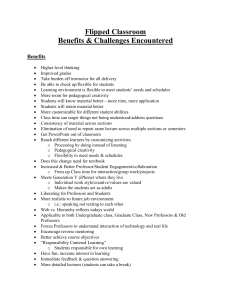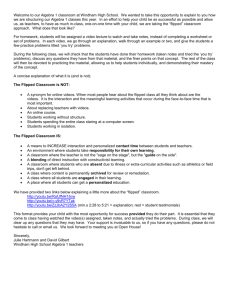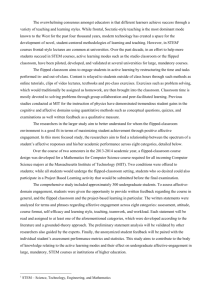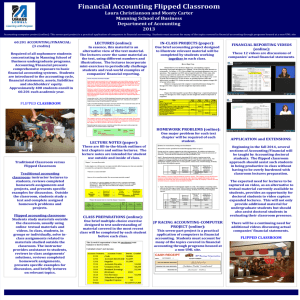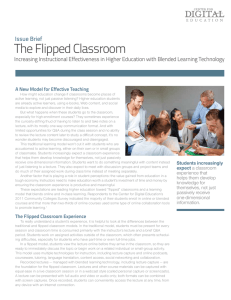Developing a Flipped Classroom for Statistics Michael Campbell
advertisement
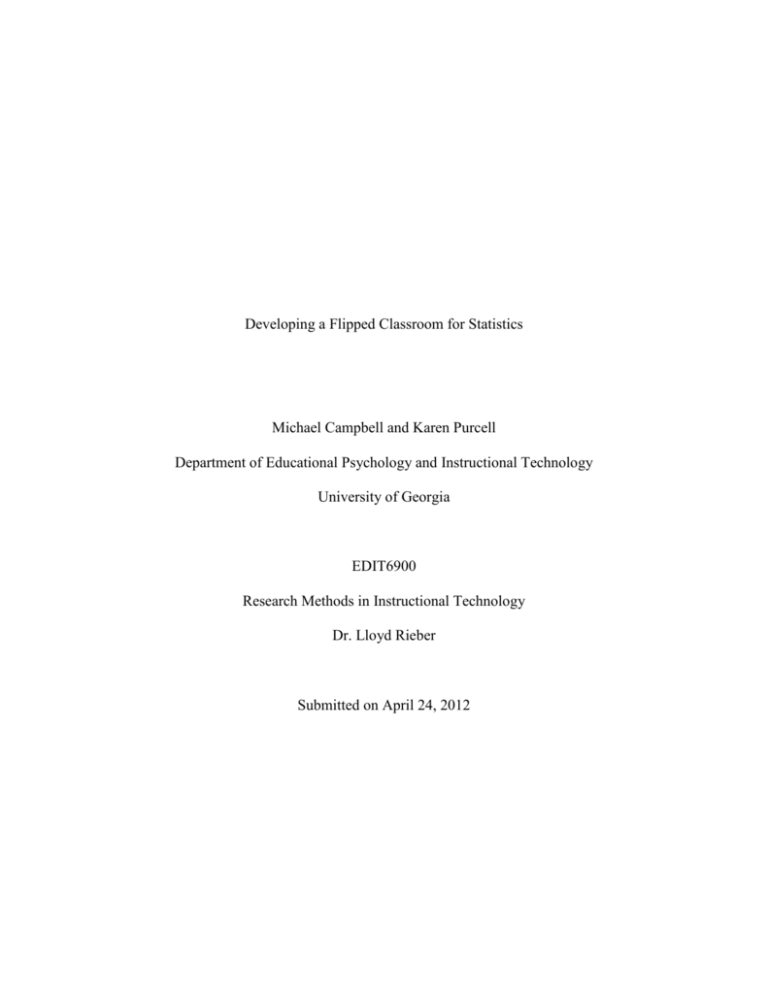
Developing a Flipped Classroom for Statistics Michael Campbell and Karen Purcell Department of Educational Psychology and Instructional Technology University of Georgia EDIT6900 Research Methods in Instructional Technology Dr. Lloyd Rieber Submitted on April 24, 2012 1 Developing Flipped Classroom for Statistics Introduction General Background Generally in the traditional statistics classroom, the information transfer takes place in class and assimilation of that information takes place outside of class. If a student has trouble with the assimilation, no one is available to provide assistance until the next day in class. The student gets frustrated and/or loses confidence in his ability. With the use of a flipped classroom, students would have their information transfer occurring outside of the classroom. They would be able to review instruction as many times needed. The flipped classroom would allow students to receive immediate reinforcement. Instruction is more easily differentiated and classroom time is efficiently used to meet individual learning needs. Purpose of Development The purpose of the development is to create an effective flipped classroom method for AP Statistics course focusing on high school level students. Statement of the need Research has shown that using a blended-classroom method enhances student participation and instructor effectiveness. According to Lang et al. (2000), students preferred a blended-classroom approach called the flipped classroom. Another study by (Hemp & Wollen, 2009) shows that student participation for in-class activities increased when the students were involved in online learning. The flipped classroom relies on students watching online lectures then participating in immersive classroom activities under the supervision of the instructor. Currently in the math classroom, students are required to listen to lecture style format and retain the information for homework activities at a time when the teacher is not available. A statistics flipped classroom format would improve the student participation and teacher satisfaction. Significance of the development This course development would allow the AP Math teacher to focus on building each individual student during activities rather than ‘giving’ a lecture during the class period. The students would benefit by becoming more active learners by participating in activities and controlling their learning online. Instructors would also benefit by having a more fully engaged class. Review of Literature The literature review will include the effectiveness of blended-learning, instructor satisfaction, and student participation in the blended-learning environment and how the flipped classroom contains the constructs to enhance the statistics classroom. In one study (Banerjee, 2013), 60% of the surveyed college students strongly agreed that the blended-learning pedagogy was effective and 70% agreed that the course expanded their knowledge of the subject. In the same study, face-to-face interactions with instructors focused on problem solving and questions which were rated 90% favorable by the students. Another study involving online and in class components showed students perception of learning in the blended group was higher than the in class group in seven topic areas (Schaber, 2010). 2 Students were shown to be very enthusiastic regarding the interactions with instructors where live problem-solving sessions were involved (Edginton, 2010) Because of the student-centered problem-solving focus of the live sessions, students came to the class expecting to ask questions and receive feedback instead of a traditional lecture style format. Instructors in Koenig’s study (Koenig, 2010) were shown to be very pleased with the increased participation thus enjoyed teaching the classes as a result. One tool that is used in the flipped-classroom for online lectures is podcasting. In a study by Kardong-Edgren 2010, podcasting was viewed by 87% of students to clarify topics and for 85% of the students helped them prepare for examinations. Another study involving the podcasting of lectures showed 85% of the students were in favor of using the lecture format as part of their studies (Gkatzidou, 2009) From an instructor’s perspective, the professors that had once stated the interactivity took too much of their time to prepare for were now saying that using the interactive class time more than offset any disadvantages of extra preparation for the classroom experience (Koenig, 2010). Another study found that online lectures as well as other content supported self-directed learning and the student was more engaged in his learning (Moore, 2010). Allowing the students to perform interactive tasks after the online material has been studied reinforces the skills the students will need to apply the skill in everyday life (Cole, 2009). In conclusion, a flipped-classroom whose hallmark attributes are independent online lectures followed by in-class problem solving activities has positive attributes of blended learning including online lectures, hands-on question and problem solving, and increased student teacher interaction. The statistics classroom would be greatly enhanced by having a more studentfocused environment during in-class sessions. Thus, developing the flipped-classroom program for statistics class would be rewarding for the student and teacher. Design Specification For the 2012-2013 school year, an implementation of a flipped classroom will be piloted in the AP Statistics classrooms at Peachtree Ridge High School. There will be approximately 60 students in the new flipped classroom. The flipped classroom will include three essential features: (a) quality instructional videos, podcast, or reading guides, (b) engaging classroom activities, and (c) robust assessments. The teacher will conduct more direct and individualized instructions, guided practice, and continuously improve the flipped model based on direct experience with the students. The students will take ownership of the material and become more actively engaged in problem solving and critical thinking that reaches beyond the traditional scope of the course. An important part of the implementation is the measurement of success. The measurements will include both qualitative measurements such as weekly surveys, semester interviews, studentteacher interaction log and quantitative measurements such as comprehension of the material present outside of class, pre- and post-test comparison, and grading using the AP Statistics rubric. 3 References Banerjee, G. (2011). Blended environments: Learning Effectiveness and Student Satisfaction at a Small College in Transition. Journal of Asynchronous Learning Networks, 15(1), pp. 8-19. Cole, J., & Kritzer, J. (2009). Strategies for Success: Teaching an Online Course. Rural Special Education Quarterly, 2009, pp. 38. Edginton, A., & Holbrook, J. (2010) A Blended Learning Approach to Teaching Basic Pharmacokinetics and the Significance of Face-to-Face Interaction. American Journal of Pharmaceutical Education, 74 (5) Article 88, pp. 1-11. Gkatzidou, S., & Pearson, E. (2009). The potential for adaptable accessible learning objects: A case study in accessible vodcasting. Australasian Journal of Educational Technology 2009, 25(2), 292-307. Kardong-Edgren, S., & Emerson, R. (2010) Student Adoption and Perception of Lecture Podcasts in Undergraduate Bachelor of Science in Nursing Courses. Journal of Nursing Education, 49(7), pp. 398-401. Koenig, K. (2010, January/February). Building Acceptance for Pedagogy Reform Through Wide-Scale Implementation of Clickers. Journal of Science and Teaching, 46-50. Lage, M., & Platt, G., & Treglia, M. (2000). Inverting the Classroom: A Gateway to Creating an Inclusive Learning Environment. Journal of Economic Education, Winter 2000, 30-43. Moore, N., & Gilmartin, M. (2010) Teaching for Better Learning: A Blended Learning Pilot Project with First-Year Geography Undergraduates. Journal of Geography in Higher Education, 34(3), pp. 327–344. 4 References Continued Rabe-Hemp, C., & Woollen, S. (2009). A Comparative Analysis of Student Engagement, Learning, and Satisfaction in Lecture Hall and Online Learning Settings. The Quarterly Review of Distance Education, Volume 10(2), 2009, pp. 207-218. Schaber, P., & Wilcox K., & Whiteside, A., & Marsh, L., & Brooks, C. (2010). Designing Learning Environments to Foster Affective Learning: Comparison of Classroom to Blended Learning, International Journal for the Scholarship of Teaching and Learning, 4(2), pp. 1-18.

